

|
|
|
1843-O/1844-O Liberty Seated Quarter Dollar - Large O Reverse
by Greg Johnson
The New Orleans mint, which began producing coins in 1838, minted
its first Liberty Seated Quarters in 1840. The struggles of the early mint are
evident in the coinage produced during the 1840’s, including the many
interesting varieties of seated quarters. Amongst those varieties are some “mintmark
size varieties”. The large O mintmark was used on the no drapery quarters
of 1840, the small O mintmark on the with-drapery quarters of 1840, ‘41,
’42, and ’43, and the large O again on all 1844 and subsequent quarters
produced prior to the civil war. Both of the transitions, from large to small
mintmark in 1840, and from small to large in 1843-44 produced rare transitional
mintmark varieties. The 1840 With Drapery Large O has already been discussed
in some detail. This column will focus on the 1843-O Large O and the 1844-O
minted using the same reverse die as the 1843-O Large O.
As already mentioned, a unique feature of 1843-O Large O reverse die (listed
in The Comprehensive Encyclopedia of Liberty Seated Quarters as reverse F) is
that it was used with two different obverse dies having different dates to produce
two different rare and interesting Liberty Seated Quarter varieties. We will
consider the two varieties separately starting with the 1843-O Large O. There
are 6 known die pairings used to strike 1843-O quarters. Five have small mintmarks
and only one has a large O. The obvious, dramatic difference in mintmark size,
noted by collectors long ago, has made the 1843-O Large O a quite well known
variety. The 1843-O Large O quarter is generally found in low grades with more
than half of the known examples grading below fine. Despite the generally low
grades, there are several high-grade coins that exist. I have personally seen
three AU examples in hand – an NGC AU58 and an NGC AU55, which are both
currently in the collections of LSCC members, and a PCGS AU53 that is for sale
in a dealer’s inventory as of this writing (11/20/2011). The finest known,
however, is the example from the Eliasberg collection sold by Bowers and Merena
at auction in April 1997. The catalog description reads:
Lot 1434 - 1843-O Large O. MS-65. A superb specimen, a dazzling
gem, almost certainly the finest known to exist – not just barely the
finest, but far and away the finest. Consider, for example, Larry Briggs’
statement, “Unkown in Uncirculated.” Consider also Walter Breen’s
comment in his Complete Encyclopedia of U.S. and Colonial Coins, “Always
in low grades, unobtainable choice.” Thus, even a MS-60 coin would be
memorable. The present gem MS-65 is simply incredible! Off the market for generations,
this piece will certainly be a stellar attraction in the cabinet of its next
owner.
The 1844-O with Reverse of 1843-O Large O, in addition to needing a much shorter
name, is far more difficult to attribute because all 1844-O quarters have large
mintmarks. The variety was, in fact, only discovered (by LSCC member Ray Lathrop)
after publication of Larry Briggs’ Comprehensive Encyclopedia of United
States Liberty Seated Quarters. In addition to being many times more rare than
the 1843-O Large O, the 1844-O also has an even lower average grade. The two
finest known at present are a cleaned example with XF40 details and a slabbed
PCGS VF35. The 1844-O with Reverse of 1843-O Large O comes in both coin and
medal turn (i.e. 180 degree die rotation) and exhibits quite heavy reverse die
cracks in later die states. The variety with die rotation appears to be the
more common of the two, but this is very likely due to the relative ease of
attribution in comparison to the variety without die rotation. Those familiar
with the die characteristics seem to encounter the two types in about equal
numbers.
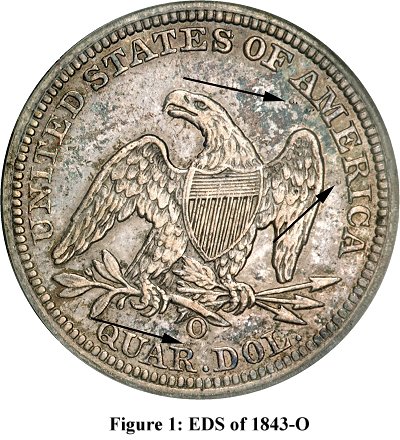
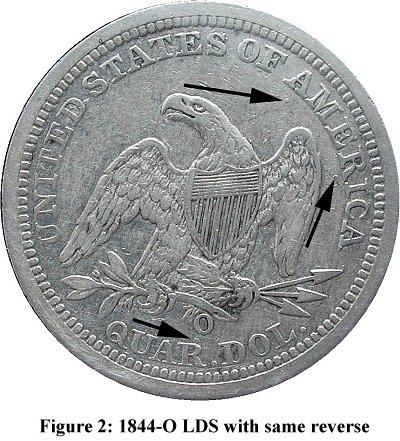
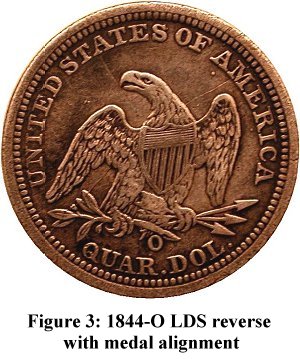
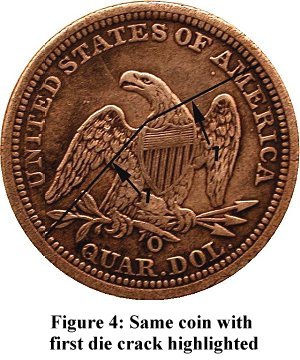
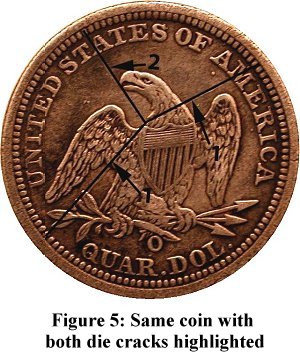
Figures 1 through 3 illustrate the die states of
the 1843-O Large O reverse die. Figure 1 is an early die state as paired with
the 1843-O obverse. Figure 2 is a later state (but still prior to the die cracks)
paired with the 1844-O obverse with coin alignment. Figure 3 shows the reverse
die when paired with the 1844-O obverse with medal alignment. Note the mintmark
location on all three coins, the prominent die lumps also present on all three
coins, and the die cracks evident in the late die state of the medal turn 1844-O
in Figure 3. Figure 4 shows the same coin as Figure 3 with the first die crack
highlighted and labeled. This crack is seen on some examples of the 1844-O with
coin alignment (i.e. prior to medal alignment coins being struck). Figure 5
shows the same coin as Figures 3 and 4 with both die cracks highlighted. All
known specimens with medal alignment have both die cracks. Because there are
so few higher-grade specimens of the 1844-O with reverse of 1843-O Large O,
it is possible that there are either coin alignment examples with both cracks
or medal alignment examples with only the first crack. If anyone has an example
of either of those die states please contact me via the e-Gobrecht editor.